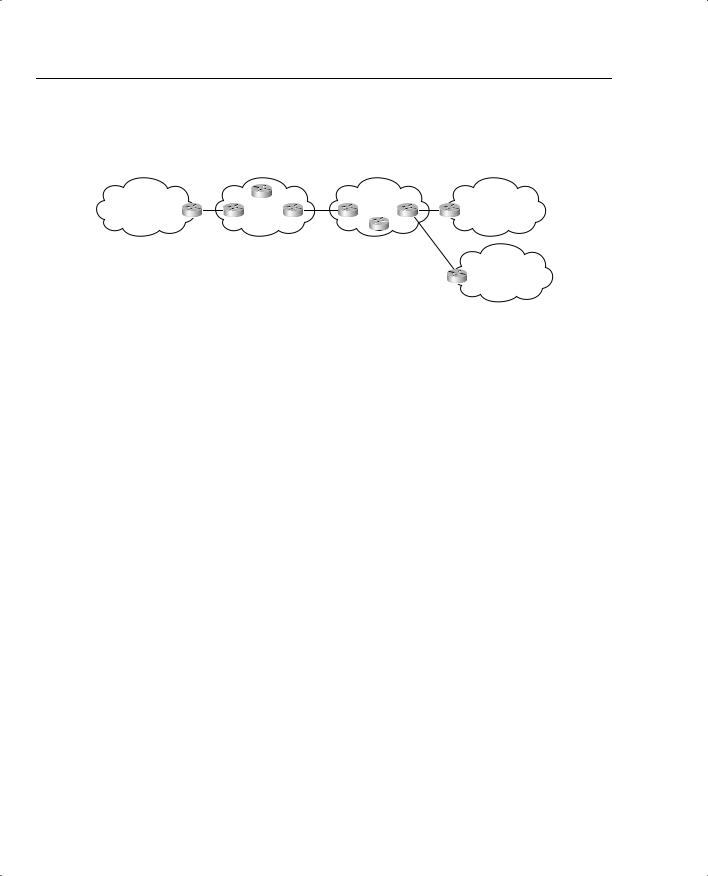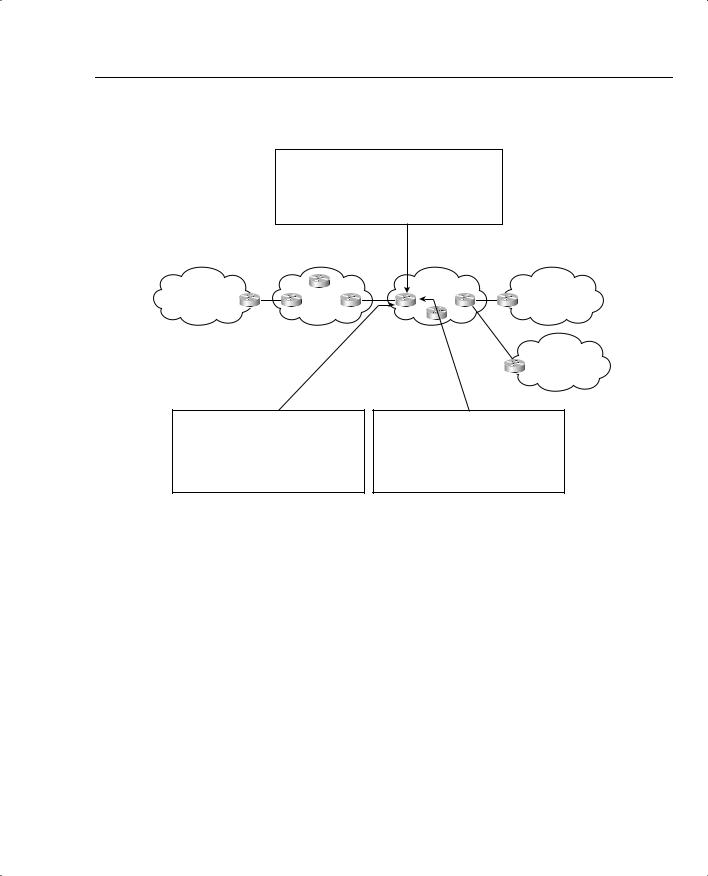
- •QoS Overview
- •“Do I Know This Already?” Quiz
- •QoS: Tuning Bandwidth, Delay, Jitter, and Loss Questions
- •Foundation Topics
- •QoS: Tuning Bandwidth, Delay, Jitter, and Loss
- •Bandwidth
- •The clock rate Command Versus the bandwidth Command
- •QoS Tools That Affect Bandwidth
- •Delay
- •Serialization Delay
- •Propagation Delay
- •Queuing Delay
- •Forwarding Delay
- •Shaping Delay
- •Network Delay
- •Delay Summary
- •QoS Tools That Affect Delay
- •Jitter
- •QoS Tools That Affect Jitter
- •Loss
- •QoS Tools That Affect Loss
- •Summary: QoS Characteristics: Bandwidth, Delay, Jitter, and Loss
- •Voice Basics
- •Voice Bandwidth Considerations
- •Voice Delay Considerations
- •Voice Jitter Considerations
- •Voice Loss Considerations
- •Video Basics
- •Video Bandwidth Considerations
- •Video Delay Considerations
- •Video Jitter Considerations
- •Video Loss Considerations
- •Comparing Voice and Video: Summary
- •IP Data Basics
- •Data Bandwidth Considerations
- •Data Delay Considerations
- •Data Jitter Considerations
- •Data Loss Considerations
- •Comparing Voice, Video, and Data: Summary
- •Foundation Summary
- •QoS Tools and Architectures
- •“Do I Know This Already?” Quiz
- •QoS Tools Questions
- •Differentiated Services Questions
- •Integrated Services Questions
- •Foundation Topics
- •Introduction to IOS QoS Tools
- •Queuing
- •Queuing Tools
- •Shaping and Policing
- •Shaping and Policing Tools
- •Congestion Avoidance
- •Congestion-Avoidance Tools
- •Call Admission Control and RSVP
- •CAC Tools
- •Management Tools
- •Summary
- •The Good-Old Common Sense QoS Model
- •GOCS Flow-Based QoS
- •GOCS Class-Based QoS
- •The Differentiated Services QoS Model
- •DiffServ Per-Hop Behaviors
- •The Class Selector PHB and DSCP Values
- •The Assured Forwarding PHB and DSCP Values
- •The Expedited Forwarding PHB and DSCP Values
- •The Integrated Services QoS Model
- •Foundation Summary
- •“Do I Know This Already?” Quiz Questions
- •CAR, PBR, and CB Marking Questions
- •Foundation Topics
- •Marking
- •IP Header QoS Fields: Precedence and DSCP
- •LAN Class of Service (CoS)
- •Other Marking Fields
- •Summary of Marking Fields
- •Class-Based Marking (CB Marking)
- •Network-Based Application Recognition (NBAR)
- •CB Marking show Commands
- •CB Marking Summary
- •Committed Access Rate (CAR)
- •CAR Marking Summary
- •Policy-Based Routing (PBR)
- •PBR Marking Summary
- •VoIP Dial Peer
- •VoIP Dial-Peer Summary
- •Foundation Summary
- •Congestion Management
- •“Do I Know This Already?” Quiz
- •Queuing Concepts Questions
- •WFQ and IP RTP Priority Questions
- •CBWFQ and LLQ Questions
- •Comparing Queuing Options Questions
- •Foundation Topics
- •Queuing Concepts
- •Output Queues, TX Rings, and TX Queues
- •Queuing on Interfaces Versus Subinterfaces and Virtual Circuits (VCs)
- •Summary of Queuing Concepts
- •Queuing Tools
- •FIFO Queuing
- •Priority Queuing
- •Custom Queuing
- •Weighted Fair Queuing (WFQ)
- •WFQ Scheduler: The Net Effect
- •WFQ Scheduling: The Process
- •WFQ Drop Policy, Number of Queues, and Queue Lengths
- •WFQ Summary
- •Class-Based WFQ (CBWFQ)
- •CBWFQ Summary
- •Low Latency Queuing (LLQ)
- •LLQ with More Than One Priority Queue
- •IP RTP Priority
- •Summary of Queuing Tool Features
- •Foundation Summary
- •Conceptual Questions
- •Priority Queuing and Custom Queuing
- •CBWFQ, LLQ, IP RTP Priority
- •Comparing Queuing Tool Options
- •“Do I Know This Already?” Quiz
- •Shaping and Policing Concepts Questions
- •Policing with CAR and CB Policer Questions
- •Shaping with FRTS, GTS, DTS, and CB Shaping
- •Foundation Topics
- •When and Where to Use Shaping and Policing
- •How Shaping Works
- •Where to Shape: Interfaces, Subinterfaces, and VCs
- •How Policing Works
- •CAR Internals
- •CB Policing Internals
- •Policing, but Not Discarding
- •Foundation Summary
- •Shaping and Policing Concepts
- •“Do I Know This Already?” Quiz
- •Congestion-Avoidance Concepts and RED Questions
- •WRED Questions
- •FRED Questions
- •Foundation Topics
- •TCP and UDP Reactions to Packet Loss
- •Tail Drop, Global Synchronization, and TCP Starvation
- •Random Early Detection (RED)
- •Weighted RED (WRED)
- •How WRED Weights Packets
- •WRED and Queuing
- •WRED Summary
- •Flow-Based WRED (FRED)
- •Foundation Summary
- •Congestion-Avoidance Concepts and Random Early Detection (RED)
- •Weighted RED (WRED)
- •Flow-Based WRED (FRED)
- •“Do I Know This Already?” Quiz
- •Compression Questions
- •Link Fragmentation and Interleave Questions
- •Foundation Topics
- •Payload and Header Compression
- •Payload Compression
- •Header Compression
- •Link Fragmentation and Interleaving
- •Multilink PPP LFI
- •Maximum Serialization Delay and Optimum Fragment Sizes
- •Frame Relay LFI Using FRF.12
- •Choosing Fragment Sizes for Frame Relay
- •Fragmentation with More Than One VC on a Single Access Link
- •FRF.11-C and FRF.12 Comparison
- •Foundation Summary
- •Compression Tools
- •LFI Tools
- •“Do I Know This Already?” Quiz
- •Foundation Topics
- •Call Admission Control Overview
- •Call Rerouting Alternatives
- •Bandwidth Engineering
- •CAC Mechanisms
- •CAC Mechanism Evaluation Criteria
- •Local Voice CAC
- •Physical DS0 Limitation
- •Max-Connections
- •Voice over Frame Relay—Voice Bandwidth
- •Trunk Conditioning
- •Local Voice Busyout
- •Measurement-Based Voice CAC
- •Service Assurance Agents
- •SAA Probes Versus Pings
- •SAA Service
- •Calculated Planning Impairment Factor
- •Advanced Voice Busyout
- •PSTN Fallback
- •SAA Probes Used for PSTN Fallback
- •IP Destination Caching
- •SAA Probe Format
- •PSTN Fallback Scalability
- •PSTN Fallback Summary
- •Resource-Based CAC
- •Resource Availability Indication
- •Gateway Calculation of Resources
- •RAI in Service Provider Networks
- •RAI in Enterprise Networks
- •RAI Operation
- •RAI Platform Support
- •Cisco CallManager Resource-Based CAC
- •Location-Based CAC Operation
- •Locations and Regions
- •Calculation of Resources
- •Automatic Alternate Routing
- •Location-Based CAC Summary
- •Gatekeeper Zone Bandwidth
- •Gatekeeper Zone Bandwidth Operation
- •Single-Zone Topology
- •Multizone Topology
- •Zone-per-Gateway Design
- •Gatekeeper in CallManager Networks
- •Zone Bandwidth Calculation
- •Gatekeeper Zone Bandwidth Summary
- •Integrated Services / Resource Reservation Protocol
- •RSVP Levels of Service
- •RSVP Operation
- •RSVP/H.323 Synchronization
- •Bandwidth per Codec
- •Subnet Bandwidth Management
- •Monitoring and Troubleshooting RSVP
- •RSVP CAC Summary
- •Foundation Summary
- •Call Admission Control Concepts
- •Local-Based CAC
- •Measurement-Based CAC
- •Resources-Based CAC
- •“Do I Know This Already?” Quiz
- •QoS Management Tools Questions
- •QoS Design Questions
- •Foundation Topics
- •QoS Management Tools
- •QoS Device Manager
- •QoS Policy Manager
- •Service Assurance Agent
- •Internetwork Performance Monitor
- •Service Management Solution
- •QoS Management Tool Summary
- •QoS Design for the Cisco QoS Exams
- •Four-Step QoS Design Process
- •Step 1: Determine Customer Priorities/QoS Policy
- •Step 2: Characterize the Network
- •Step 3: Implement the Policy
- •Step 4: Monitor the Network
- •QoS Design Guidelines for Voice and Video
- •Voice and Video: Bandwidth, Delay, Jitter, and Loss Requirements
- •Voice and Video QoS Design Recommendations
- •Foundation Summary
- •QoS Management
- •QoS Design
- •“Do I Know This Already?” Quiz
- •Foundation Topics
- •The Need for QoS on the LAN
- •Layer 2 Queues
- •Drop Thresholds
- •Trust Boundries
- •Cisco Catalyst Switch QoS Features
- •Catalyst 6500 QoS Features
- •Supervisor and Switching Engine
- •Policy Feature Card
- •Ethernet Interfaces
- •QoS Flow on the Catalyst 6500
- •Ingress Queue Scheduling
- •Layer 2 Switching Engine QoS Frame Flow
- •Layer 3 Switching Engine QoS Packet Flow
- •Egress Queue Scheduling
- •Catalyst 6500 QoS Summary
- •Cisco Catalyst 4500/4000 QoS Features
- •Supervisor Engine I and II
- •Supervisor Engine III and IV
- •Cisco Catalyst 3550 QoS Features
- •Cisco Catalyst 3524 QoS Features
- •CoS-to-Egress Queue Mapping for the Catalyst OS Switch
- •Layer-2-to-Layer 3 Mapping
- •Connecting a Catalyst OS Switch to WAN Segments
- •Displaying QoS Settings for the Catalyst OS Switch
- •Enabling QoS for the Catalyst IOS Switch
- •Enabling Priority Queuing for the Catalyst IOS Switch
- •CoS-to-Egress Queue Mapping for the Catalyst IOS Switch
- •Layer 2-to-Layer 3 Mapping
- •Connecting a Catalyst IOS Switch to Distribution Switches or WAN Segments
- •Displaying QoS Settings for the Catalyst IOS Switch
- •Foundation Summary
- •LAN QoS Concepts
- •Catalyst 6500 Series of Switches
- •Catalyst 4500/4000 Series of Switches
- •Catalyst 3550/3524 Series of Switches
- •QoS: Tuning Bandwidth, Delay, Jitter, and Loss
- •QoS Tools
- •Differentiated Services
- •Integrated Services
- •CAR, PBR, and CB Marking
- •Queuing Concepts
- •WFQ and IP RTP Priority
- •CBWFQ and LLQ
- •Comparing Queuing Options
- •Conceptual Questions
- •Priority Queuing and Custom Queuing
- •CBWFQ, LLQ, IP RTP Priority
- •Comparing Queuing Tool Options
- •Shaping and Policing Concepts
- •Policing with CAR and CB Policer
- •Shaping with FRTS, GTS, DTS, and CB Shaping
- •Shaping and Policing Concepts
- •Congestion-Avoidance Concepts and RED
- •WRED
- •FRED
- •Congestion-Avoidance Concepts and Random Early Detection (RED)
- •Weighted RED (WRED)
- •Flow-Based WRED (FRED)
- •Compression
- •Link Fragmentation and Interleave
- •Compression Tools
- •LFI Tools
- •Call Admission Control Concepts
- •Local-Based CAC
- •Measurement-Based CAC
- •Resources-Based CAC
- •QoS Management Tools
- •QoS Design
- •QoS Management
- •QoS Design
- •LAN QoS Concepts
- •Catalyst 6500 Series of Switches
- •Catalyst 4500/4000 Series of Switches
- •Catalyst 3550/3524 Series of Switches
- •Foundation Topics
- •QPPB Route Marking: Step 1
- •QPPB Per-Packet Marking: Step 2
- •QPPB: The Hidden Details
- •QPPB Summary
- •Flow-Based dWFQ
- •ToS-Based dWFQ
- •Distributed QoS Group–Based WFQ
- •Summary: dWFQ Options

832 Appendix B: Topics on the CCIP QoS Exam: Topics on the CCIP QoS Exam
Foundation Topics
For those of you studying for both exams, you could begin by studying for, and passing, the DQOS exam. To study, you could just attack each chapter of this book in succession, and ignore this appendix. After you have passed the DQOS exam, you can then study using this appendix, and pick up the additional information you need.
For those of you just studying for the CCIP QoS exam, not only should you plan to study the topics in this chapter, you can also ignore some topics in the core chapters of this book. The Introduction to this book suggests some options for your study plan when studying just for the QoS exam. Table B-1 summarizes the major topics from Chapters 1 through 10 that you can ignore if you are preparing just for the QoS exam.
Table B-1 Preparing for the QOS Exam
Book |
|
Chapter |
Suggested Deviation as Compared with DQOS Study Plan |
|
|
1 |
None; read and study the entire chapter. |
|
|
2 |
None; read and study the entire chapter. |
|
|
3 |
Read and study all of Chapter 3; then come to this appendix and read the section “QoS |
|
Policy Propagation with BGP (QPPB).” QPPB is the one classification and marking tool |
|
that is on the QoS exam, but not on the DQOS exam. |
|
|
4 |
Read and study Chapter 3 entirely; then come to this appendix and read the section |
|
“Congestion Management (Queuing).” This section covers several queuing tools not |
|
covered on the DQOS exam. |
|
|
5 |
None; read and study the entire chapter. |
|
|
6 |
None; read and study the entire chapter. |
|
|
7 |
None; read and study the entire chapter. |
|
|
8 |
Ignore all topics covering voice CAC, but do read all coverage of RSVP. |
|
|
9 |
You do not need to read this chapter; the topics are not covered on the QoS exam. |
|
|
10 |
You do not need to read this chapter; the topics are not covered on the QoS exam. |
|
|
Any time you study for a Cisco exam, you should always pull a list of exam topics from www.cisco.com for the exam. Use these exam topics as your primary guide to know what to study for the exam; after all, the exam questions typically test whether you can do what the exam topic describes. As mentioned in the Introduction to this book, you can also check www.ciscopress.com/1587200589, where the authors of this book will post hints and tips when exam changes occur.

Classification and Marking 833
Classification and Marking
Chapter 3, “Classification and Marking,” covers classification and marking tools. QoS policy propagation with BGP (QPPB) is the one tool in this category that is on the QoS exam, but not on the DQOS exam.
QoS Policy Propagation with BGP (QPPB)
QoS policies that differentiate between different types of traffic can be most easily defined for a single enterprise network. For instance, one enterprise may want to treat important web traffic, not-important web traffic, and all other data traffic as three different classes, and use different classes for voice and video traffic. For the Internet, however, a single QoS policy would never work. Differentiated services (DiffServ), which was designed specifically to address QoS over the Internet, defines the role of ingress boundary nodes to re-mark traffic as it enters a different DiffServ domain, essentially changing the differentiated services code point (DSCP) to reflect the QoS policies of each respective DiffServ domain. This practice allows each DiffServ domain to set its own QoS policies.
QoS policies that classify traffic based on the characteristics of the flow—voice, video, different data applications, and so on—can be defined and used in enterprises and by service providers. Enterprises can afford to be more selective, because a single group can often set the QoS policies. For instance, an enterprise could classify based on the IP addresses of some missioncritical servers. QoS policies for Internet service providers (ISPs) tend to be less specific than those for an enterprise, because ISPs have many customers. However, ISPs can still implement QoS policies based on the type of traffic contained in the packet.
ISPs may want a QoS policy just to prefer one customer’s traffic over another. In Figure B-1, for instance, consider ISP 1, which has two customers. Customer 1 has agreed to pay a premium for its Internet service, in return for ISP 1 agreeing to provide better latency and delay characteristics for the traffic. Customer 2 keeps paying the same amount as always, and still gets besteffort service.
The QoS tools only need to differentiate between Customer 1 and Customer 2 traffic to support this policy. So, for packets flowing from right to left, if the source IP address is an IP address in Customer 1’s network, the packet might be marked with precedence 4, for instance. Similarly, when packets flow left to right, these same tools could examine the destination IP address, and if it’s part of Customer 1’s network, precedence 4 could be marked. Packets to or from Customer 2 could be marked with precedence 0.

834 Appendix B: Topics on the CCIP QoS Exam
Figure B-1 QoS Policy Based on Customer—Customer 1 and Customer 2
|
ISP2 |
|
ISP1 |
|
AS 100 |
AS 200 |
|
AS 300 |
AS 400 |
Customer 3 |
|
|
|
Customer 1 — |
|
|
|
Network 1 |
|
|
|
R2 |
|
|
|
R1 |
R3 |
R4 |
|
|
|
|
|
Customer 2 — |
|
|
|
|
Network 2 |
|
|
|
|
AS 500 |
Class-based (CB) marking, policy-based routing (PBR), and committed access rate (CAR) could perform the necessary marking to support premium and best-effort customer services. However, each of these three tools has some negative side effects. For all three tools, that classification would require an IP ACL for matching the packets, for all packets. For an ISP with many customers, however, classifying and marking packets based on referencing ACLs for a large number of packets may induce too much overhead traffic. Suppose further that ISP 1 and ISP 2 agree to support each other’s premium and best-effort customers in a similar manner. The two ISP’s would have to continually exchange information about which networks are premium, and which are not, if they are using IP ACLs to classify the traffic. Additionally, when new customers are added, ISP 1 may be waiting on ISP 2 to update their QoS configuration before the desired level of service is offered to the new customer.
To overcome the two issues—the scalability of classifying based on ACLs, and the administrative problems of just listing the networks that need premium services—QPPB was created. QPPB allows marking of packets based on an IP precedence or QoS group value associated with a Border Gateway Protocol (BGP) route. For instance, the BGP route for Customer 1’s network, Network A, could be given a BGP path attribute that both ISP 1 and ISP 2 agree should mean that this network receives better QoS service. Because BGP already advertises the routes, and the QoS policy is based on the networks described in the routes, QPPB marking can be done more efficiently than with the other classification and marking tools.
Figure B-2 shows the basic process in action. In this example, R3 is configured to use QPPB, although it would likely be used in several places around the network.
QPPB follows two steps: marking routes, and then marking packets based on the values marked on the routing entries. BGP routing information includes the network numbers used by the various customers, and other BGP path attributes. Because Cisco has worked hard over the years to streamline the process of table lookup in the routing table, to reduce per-packet processing for the forwarding process, QPPB can use this same efficient table-lookup process to reduce classification and marking overhead.

Classification and Marking 835
Figure B-2 QPPB—Basic Components
Step 1: BGP Routing Table
Classify:
Check BGP learned routes against a route-map
Mark:
IP Precedence and QoS Group of matched route, if any
ISP2
AS 100 |
AS 200 |
Customer 3
R1
Step 2: Classify Based on Route:
Check the destination IP address of packet versus routing table
Mark Packet:
IP Precedence or QoS Group of matched route, if any
ISP1
AS 300 |
AS 400 |
Customer 1 —
Network 1
R2 |
R3 |
R4 |
Customer 2 —
Network 2
AS 500
Step 2: Classify Based on Route:
Check the source IP address of packet versus routing table
Mark Packet:
IP Precedence or QoS Group of matched route, if any
For reference, Tables B-2 and B-3 summarize the QPPB configuration and exec commands, respectively.
Table B-2 |
Configuration Command Reference for QPPB |
|
|
|
|
|
Command |
Mode and Function |
|
|
|
|
route-map map-tag [permit | deny] |
Global command; creates a route map entry |
|
[sequence-number] |
|
|
|
|
|
match ip address {access-list-number | |
Route-map subcommand; used to match IP packets |
|
access-list-name} [... access-list-number | ... |
based on parameters matchable with an IP ACL |
|
access-list-name] |
|
|
|
|
|
match length minimum-length maximum- |
Route-map subcommand; used to mach IP packets |
|
length |
based on their length |
|
|
|
|
set ip precedence number | name |
Route-map subcommand; sets IP precedence vale |
|
|
using the decimal number of name. |
|
|
|
continues

836 Appendix B: Topics on the CCIP QoS Exam
Table B-2 |
Configuration Command Reference for QPPB (Continued) |
|
|
|
|
|
Command |
Mode and Function |
|
|
|
|
set ip qos-group group-id |
Route-map subcommand; sets a group ID in the |
|
|
routing table for classification throughout the network. |
|
|
|
|
table-map map-name |
BGP subcommand; used to modify values related to |
|
|
BGP learned routes, including precedence and QoS |
|
|
group |
|
|
|
|
ip community-list community-list-number |
Global command; used to create a community list, |
|
{permit | deny} community-number |
which matches values in the BGP community string |
|
|
|
|
ip as-path access-list access-list-number |
Global command; used to create an autonomous |
|
{permit | deny} as-regexp |
system (AS) path list, which matches values in the |
|
|
autonomous system number (ASN) path BGP attribute |
|
|
|
|
ip bgp-community new-format |
BGP subcommand; used to make IOS use the AA:NN |
|
|
format for community values, with AA being the ASN, |
|
|
and NN being a user-defined value |
|
|
|
|
bgp-policy ip-prec-map |
Interface subcommand; enables QPPB for packets |
|
|
entering the interface, marking IP precedence |
|
|
|
|
bgp-policy ip-qos-map |
Interface subcommand; enables QPPB for packets |
|
|
entering the interface, marking QoS group |
|
|
|
Table B-3 |
Exec Command Reference for QPPB |
|
|
|
|
|
Command |
Function |
|
|
|
|
show ip bgp |
Shows BGP routing table |
|
|
|
|
show ip route prefix |
Shows IP routing table entries, including precedence |
|
|
values |
|
|
|
|
show ip bgp community-list community-list- |
Lists configuration of the community list |
|
number |
|
|
|
|
|
show ip cef network |
Shows the Cisco Express Forwarding (CEF) |
|
|
Forwarding Information Base (FIB), including the |
|
|
marked QoS values |
|
|
|
QPPB can be a confusing topic. The rest of this section discusses more detail about how QPPB works and how to configure it. One key to understanding QPPB, in spite of some of the detail, is to keep these two key points in mind as you read the following sections:
•QPPB classifies BGP routes based on the BGP routes’ attributes, and marks BPG routes with an IP precedence or QoS group value.
•QPPB classifies packets based on the associated routing table entries, and marks the packets based on the marked values in the routing table entry.
